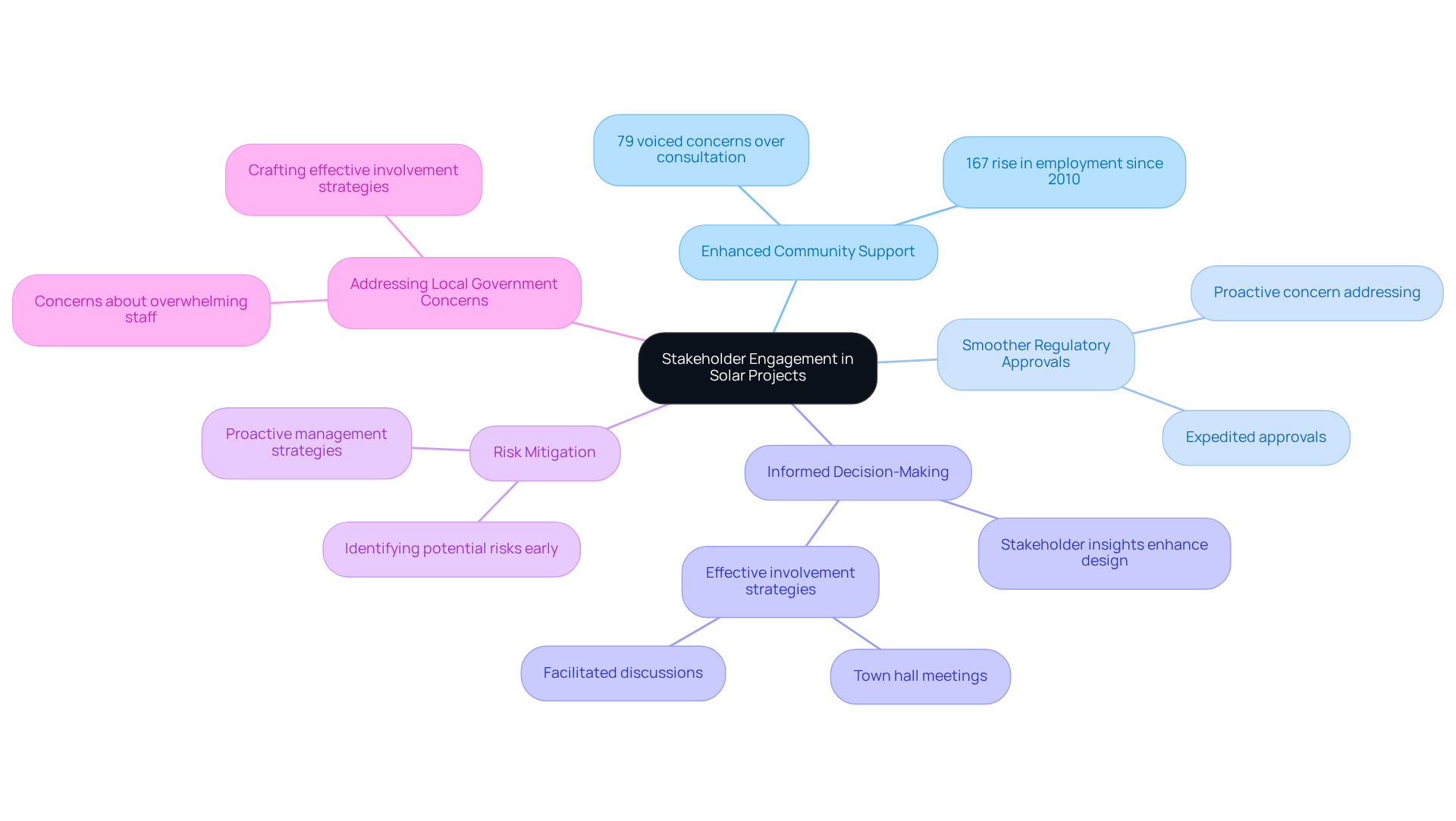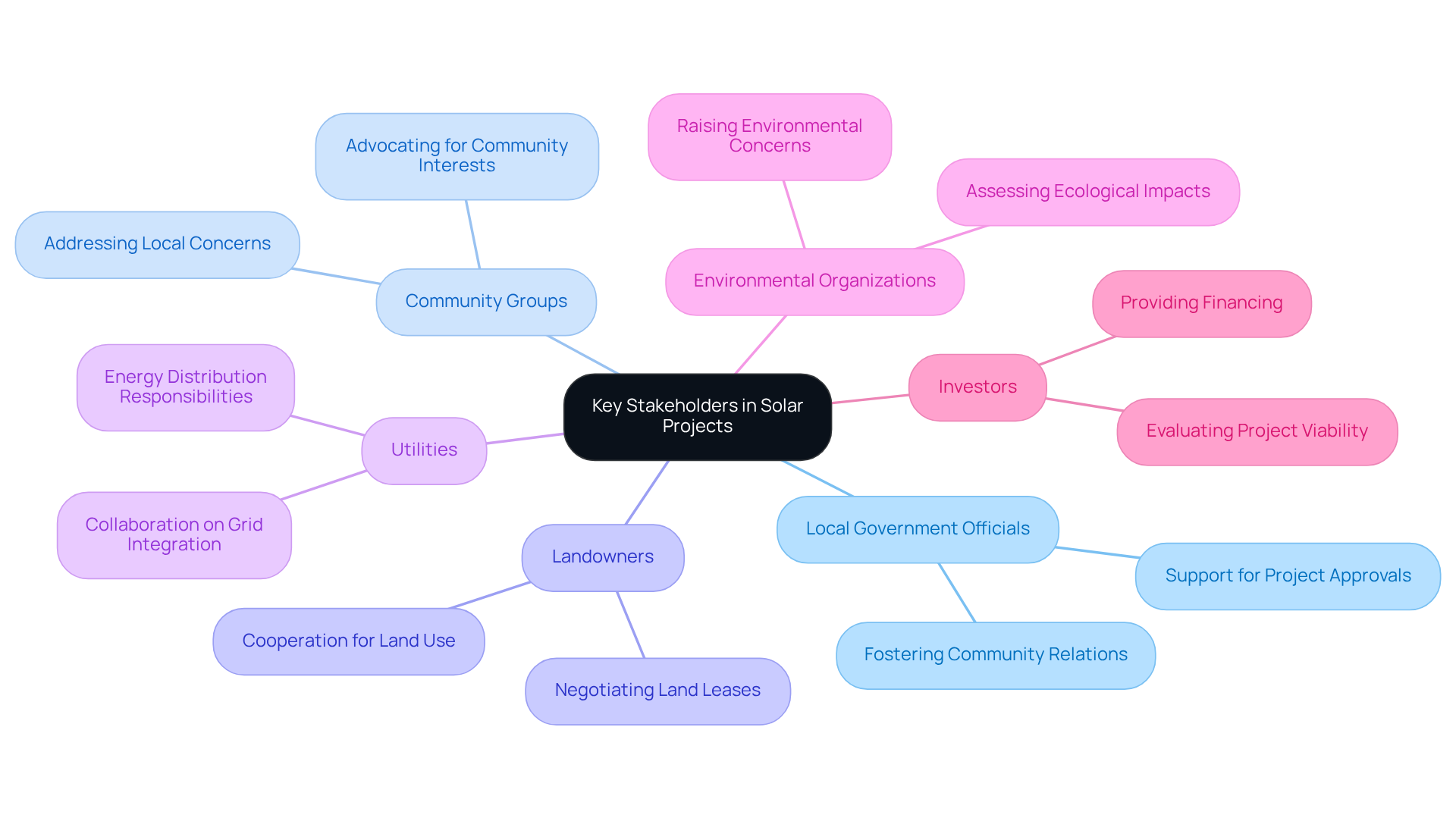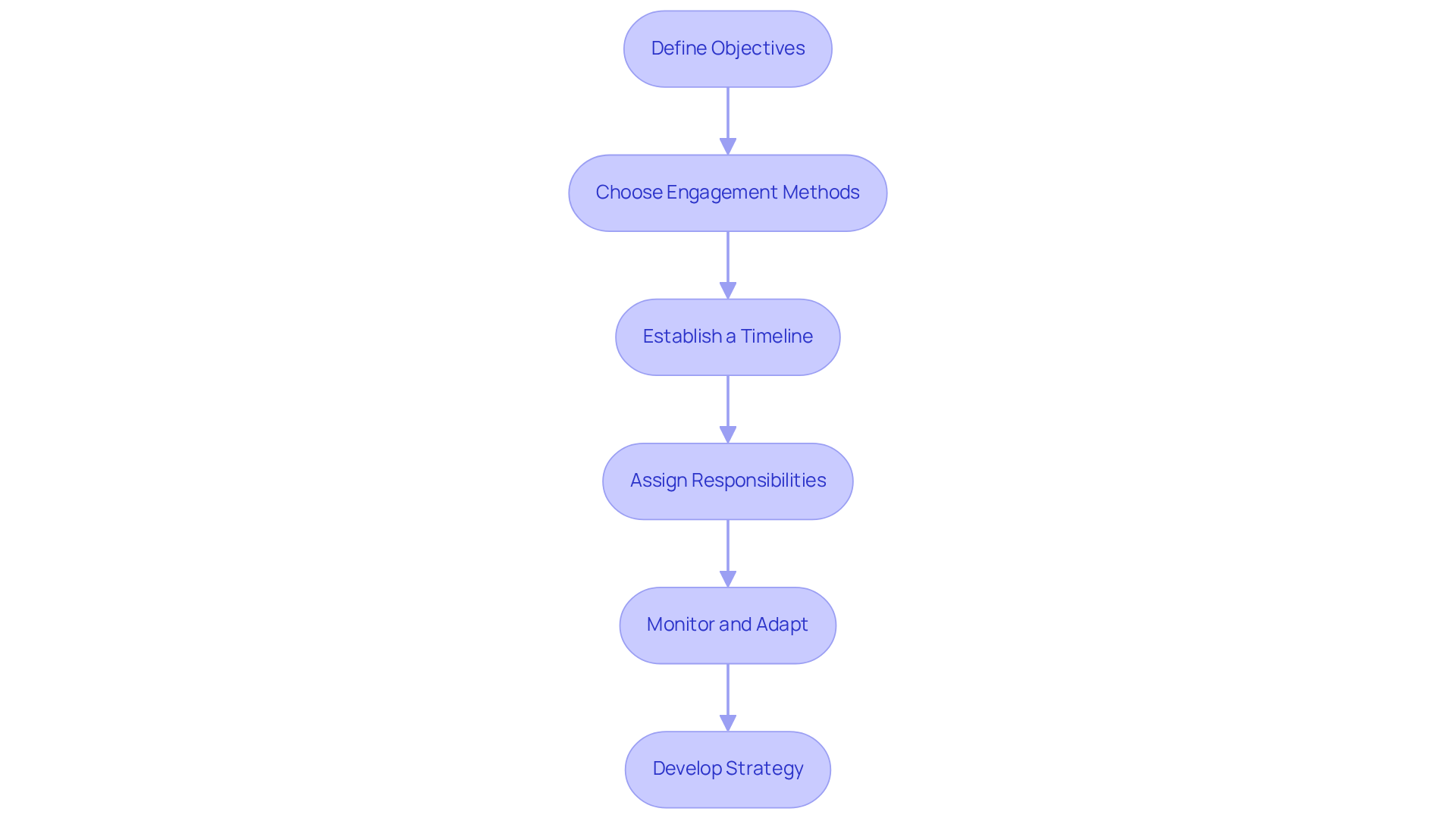Overview
Effective stakeholder engagement is paramount for the successful development of solar projects. It not only fosters community support but also streamlines regulatory approvals and enhances decision-making processes. Proactive involvement of stakeholders mitigates risks and addresses local government concerns. Moreover, it aligns project goals with community needs, ultimately contributing to the success of renewable energy initiatives. Engaging stakeholders effectively is not just a strategy; it is a necessity for achieving long-term project success.
Introduction
The transition to renewable energy is not solely dependent on technology; it demands a concerted effort to engage the communities and individuals impacted by solar projects. Effective stakeholder engagement fosters community support, streamlines regulatory processes, and enhances project outcomes. However, the challenge persists: how can developers ensure that all voices are heard and integrated into the planning stages? This article explores essential strategies for mastering stakeholder engagement in solar projects, offering insights that can transform potential opposition into enthusiastic collaboration.
Understand the Importance of Stakeholder Engagement in Solar Projects
The active participation of individuals and groups who are impacted by or interested in the endeavor is essential, highlighting that solar project stakeholder engagement stands as a crucial pillar in the advancement of solar initiatives. This approach offers several significant benefits:
-
Enhanced Community Support: Engaging local communities enables developers to cultivate goodwill, transforming potential opposition into advocates for the project. This is particularly pertinent, as 79% of participants in recent discussions voiced concerns over insufficient consultation with local communities regarding renewable projects. Moreover, the renewable energy sector has witnessed a 167% rise in employment since 2010, underscoring the economic advantages that community backing can foster.
-
Smoother Regulatory Approvals: Early stakeholder involvement empowers developers to proactively address concerns, streamlining the regulatory review process. This can result in expedited approvals, which is vital in a landscape where new permitting requirements for solar and battery storage facilities are being instituted.
-
Informed Decision-Making: Stakeholders often provide invaluable insights that enhance design and execution, ensuring alignment with community needs and expectations. For example, effective involvement strategies—such as town hall meetings and facilitated discussions—have proven successful in gathering diverse perspectives and fostering collaboration. A case study on engaging interested parties in the renewable energy transition illustrates the importance of building understanding and trust within local communities, demonstrating how effective involvement strategies yield successful project outcomes.
-
Risk Mitigation: By comprehending the views of involved parties, developers can pinpoint potential risks and conflicts early in the process, facilitating proactive management strategies. Case studies indicate that early engagement with stakeholders significantly reduces barriers to renewable energy development, ensuring more efficient permitting and installation procedures. As Brena Lacerda, Senior Community Engagement Analyst II at Voltalia, remarked, "The possibilities for emerging issues are endless. Through our feedback portal and increased local communication, we can learn about different situations where we can take action."
-
Addressing Local Government Concerns: It is equally essential to acknowledge that local government staff may be apprehensive about being overwhelmed by initiatives aimed at promoting renewable energy installation. Recognizing these challenges can aid in crafting more effective involvement strategies.
Focusing on solar project stakeholder engagement transcends mere recommendation; it is imperative for the successful creation and management of renewable energy initiatives, ultimately contributing to the achievement of clean energy objectives and community endorsement.

Identify Key Stakeholders in Your Solar Project
Recognizing key participants is crucial for successful solar project stakeholder engagement in initiatives. A systematic approach to identifying these stakeholders is essential:
-
Create a Stakeholder List: Begin by compiling a comprehensive list of potential stakeholders, including:
- Local Government Officials: Their support is vital for project approvals and fostering positive community relations.
- Community Groups: Local organizations that advocate for community interests and concerns.
- Landowners: Individuals or entities possessing land where the initiative may be developed, whose cooperation is essential.
- Utilities: Firms responsible for energy distribution, critical to execution.
- Environmental Organizations: Groups focused on the ecological impacts of the initiative, which may raise concerns.
- Investors and Financial Institutions: Entities that provide the necessary financing for the execution of initiatives.
-
Classify Participants: After listing the individuals involved, classify them according to their influence and interest in the project. Utilize a matrix to map their influence against their interest levels, aiding in prioritizing engagement efforts effectively.
-
Research Participant Interests: Gain insights into what each group values. This can be accomplished through surveys, interviews, or examining existing literature on community issues related to solar initiatives. Understanding these interests is key to addressing potential objections and fostering support.
-
Engage Early: Initiate contact with interested parties during the early planning stages. This could involve hosting informational meetings or workshops to present the initiative and gather initial feedback. Involving interested parties early can significantly improve acceptance and mitigate future challenges.
By adhering to these steps, you ensure that all pertinent parties are recognized and involved in solar project stakeholder engagement, establishing a strong foundation for a successful renewable energy initiative. This proactive approach not only facilitates smoother project development but also aligns with the increasing emphasis on solar project stakeholder engagement in energy initiatives.
In the photovoltaic sector, which accounted for 67% of all new electricity-generating capacity introduced to the U.S. grid in the first half of 2024, solar project stakeholder engagement is more critical than ever. As noted by Wood Mackenzie, 'The U.S. photovoltaic sector remains the foundation of the energy transition, but additional support is required.' This highlights the importance of solar project stakeholder engagement to ensure the success of solar initiatives.

Develop a Stakeholder Engagement Plan
A well-organized participant involvement strategy is essential for ensuring effective communication and cooperation throughout the course of the initiative. To develop one, follow these steps:
-
Define Objectives: Clearly outline what you aim to achieve through stakeholder engagement. This may involve gaining support, addressing concerns, or gathering input on the initiative's design. Focus on nurturing community trust and ensuring initiative acceptance, both vital for successful outcomes.
-
Choose Engagement Methods: Select suitable approaches for involving interested parties based on their preferences and the initiative's nature. Options include:
- Public Meetings: Present project information and gather community feedback, ensuring transparency and building trust.
- Surveys: Collect opinions and concerns from a broader audience, allowing for diverse input. Notably, over two-thirds of Americans favor renewables over fossil fuels, indicating strong public support for renewable initiatives.
- Workshops: Facilitate in-depth discussions and collaborative problem-solving, enhancing participant involvement.
- One-on-One Meetings: Address important participants who may require personalized attention, fostering deeper relationships.
-
Establish a Timeline: Create a timeline for interaction activities, aligning them with project milestones. This keeps interested parties informed and engaged at crucial phases, fostering a sense of ownership and dedication.
-
Assign Responsibilities: Designate team members accountable for different facets of participant involvement. This ensures accountability and a coordinated approach, enhancing the effectiveness of communication strategies.
-
Monitor and Adapt: Continuously observe input from interested parties and the effectiveness of involvement. Be ready to adjust your approaches based on participant reactions and evolving dynamics. For instance, as Angela Rodgers highlights, customizing communication for local contexts and issues is crucial for effective involvement.
By creating a thorough solar project stakeholder engagement strategy, you can cultivate positive relationships and ensure that stakeholder opinions are acknowledged throughout the solar development process. This proactive approach not only enhances project acceptance but also contributes to the broader goals of sustainable development and social responsibility. Additionally, referencing successful case studies, such as the Clean Energy Council's best practices for community engagement, can provide concrete examples of effective strategies in action.

Conclusion
Engaging stakeholders effectively is not merely a beneficial practice; it stands as a fundamental requirement for the successful development of solar projects. By prioritizing stakeholder involvement, developers can ensure that their initiatives resonate with community interests, streamline regulatory processes, and ultimately contribute to a more sustainable energy landscape.
The article delineates several key strategies for achieving successful stakeholder engagement. These include:
- Identifying key stakeholders
- Developing a comprehensive engagement plan
- Recognizing the importance of early and ongoing communication
By fostering relationships with local communities, government officials, and other relevant parties, solar developers can mitigate risks, enhance project acceptance, and harness invaluable insights that refine project execution.
In conclusion, the significance of stakeholder engagement in solar energy projects cannot be overstated. As the demand for renewable energy continues to escalate, embracing effective engagement strategies will be crucial for overcoming challenges and ensuring the success of solar initiatives. By committing to transparent communication and collaboration, stakeholders can contribute to a cleaner, more sustainable future for all.
Frequently Asked Questions
Why is stakeholder engagement important in solar projects?
Stakeholder engagement is crucial in solar projects as it enhances community support, smoothens regulatory approvals, informs decision-making, mitigates risks, and addresses local government concerns, all of which contribute to the successful advancement of solar initiatives.
How does engaging local communities benefit solar project developers?
Engaging local communities helps developers cultivate goodwill, turning potential opposition into advocates for the project. This community backing can lead to economic advantages, as evidenced by a 167% rise in employment in the renewable energy sector since 2010.
What impact does early stakeholder involvement have on regulatory approvals?
Early stakeholder involvement allows developers to proactively address concerns, which can streamline the regulatory review process and result in expedited approvals, particularly important as new permitting requirements for solar and battery storage facilities are introduced.
In what ways do stakeholders contribute to informed decision-making in solar projects?
Stakeholders provide valuable insights that enhance project design and execution, ensuring alignment with community needs. Effective involvement strategies, such as town hall meetings, help gather diverse perspectives and foster collaboration.
How does stakeholder engagement help in risk mitigation for solar projects?
By understanding the views of involved parties, developers can identify potential risks and conflicts early in the process, allowing for proactive management strategies that reduce barriers to renewable energy development.
What concerns might local government staff have regarding renewable energy initiatives?
Local government staff may be apprehensive about being overwhelmed by initiatives aimed at promoting renewable energy installation. Recognizing these challenges is essential for developing effective stakeholder involvement strategies.
What is the overall significance of focusing on stakeholder engagement in solar projects?
Focusing on stakeholder engagement is imperative for the successful creation and management of renewable energy initiatives, ultimately contributing to the achievement of clean energy objectives and gaining community endorsement.
List of Sources
- Understand the Importance of Stakeholder Engagement in Solar Projects
- How inclusive stakeholder engagement can transform your infrastructure projects | illuminem (https://illuminem.com/illuminemvoices/how-inclusive-stakeholder-engagement-can-transform-your-infrastructure-projects)
- Important Stakeholder Sessions – Clean Energy Siting & Permitting/Grid Equity Act - Massachusetts Association of Conservation Commissions (https://maccweb.org/news/697445/Important-Stakeholder-Sessions--Clean-Energy-Siting--PermittingGrid-Equity-Act.htm)
- Stakeholder Engagement Tool: Toward a Renewable Energy Standard | Voltalia (https://voltalia.com/news-releases/news-release-details/blog/stakeholder-engagement-tool-toward-renewable-energy-standard)
- Solar Energy Toolkit: Stakeholder Engagement | SolSmart (https://solsmart.org/resource/stakeholder-engagement)
- Stakeholder Engagement & The Transition to Renewable Energy (https://simplystakeholders.com/engagement-transition-to-renewable-energy)
- Identify Key Stakeholders in Your Solar Project
- Solar Market Insight Report Q3 2024 – SEIA (https://seia.org/research-resources/solar-market-insight-report-q3-2024)
- Census Solar Job Trends (https://irecusa.org/census-solar-job-trends)
- Develop a Stakeholder Engagement Plan
- Stakeholder Engagement & The Transition to Renewable Energy (https://simplystakeholders.com/engagement-transition-to-renewable-energy)
- (PDF) Stakeholder engagement and influence: Strategies for successful energy projects (https://researchgate.net/publication/382514218_Stakeholder_engagement_and_influence_Strategies_for_successful_energy_projects)




